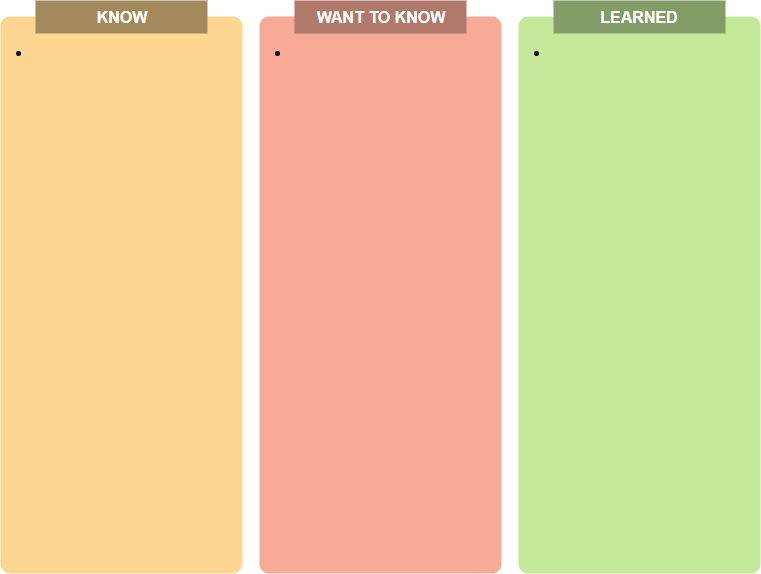A KWL Chart (also known as KWL chart, KWL Table) is a graphical organizer designed to help in learning. People use KWL Chart as a graphic means of establishing what Learners know, what they want to know, and what they learned about a given topic. Thus, KWL is an acronym of “What I Know”, “What I want to Wonder”, and ultimately “What I Learned”. It helps learners reflect and evaluate their learning experience, as well as serve as a useful assessment tool for the lesson. A KWL is often structured in tabular form and is typically divided into three columns titled in its short form: Know, Want and Learned.

KWL Chart Template
Choose a general topic and create a KWL table with three columns and two rows. One row for the headings and one larger one in which to write. Label the first column with
- K for “What I Know”: Introduce the topic and brainstorm with the class. Note down responses.
- W for “What I Want to Know”: Record any questions the class has about the topic and/or turn textbook subheadings into questions.
- L for “What I Learned”: After reading or listening record what leaners say they have learned. Note any W questions that were answered.

3 Steps for Creating a KWL Chart?
What I Know (K)?
- Brainstorm what students already know about a specific subject topic.
- Highlight the importance of prior learning and how life experiences and making connections to what we already know is a very important part of learning.
- Write these ideas under the K column.
What Do I Want to Know (W)?
- Generate a list of what else they want to learn or questions they want to be answered.
- Continue to demonstrate how to organize and categorize their suggestions and how to use this information to set a purpose for reading.
- Students can also turn textbook headings and subheadings into questions for the W column.
- Students now read (or listen) the text and actively look for answers to their questions as well as to verify their knowledge.
What I Learned (L)?
- After reading with the purpose they discuss and record what they learned in the L column, especially paying attention to W questions that were answered from the text or activity.
- Provide multiple opportunities for learners to use the strategy in pairs or small groups until they can use the strategy independently.
- The L column can also serve as notes for review and revision.
Extended KWL Chart
The table comes in various forms as some have modified it to include or exclude information. For example, we can extend the learning all that is needed is to add a few letters of the alphabet (F / S /D): the extended KWL Chart template is shown below:
Find: Have students explain how they will find out what they want to learn. This allows students to direct the next steps of the learning process.
Share: Students can then explain how they will share what they learned. This allows students to use their creativity in relaying relevant information.
Do: Finally, students can reflect on what they have already done and what they will do next time. Reflection is often the most important piece that is overlooked.
Learners need to be allowed to reflect on the lesson to rebuild their understanding of the content.
